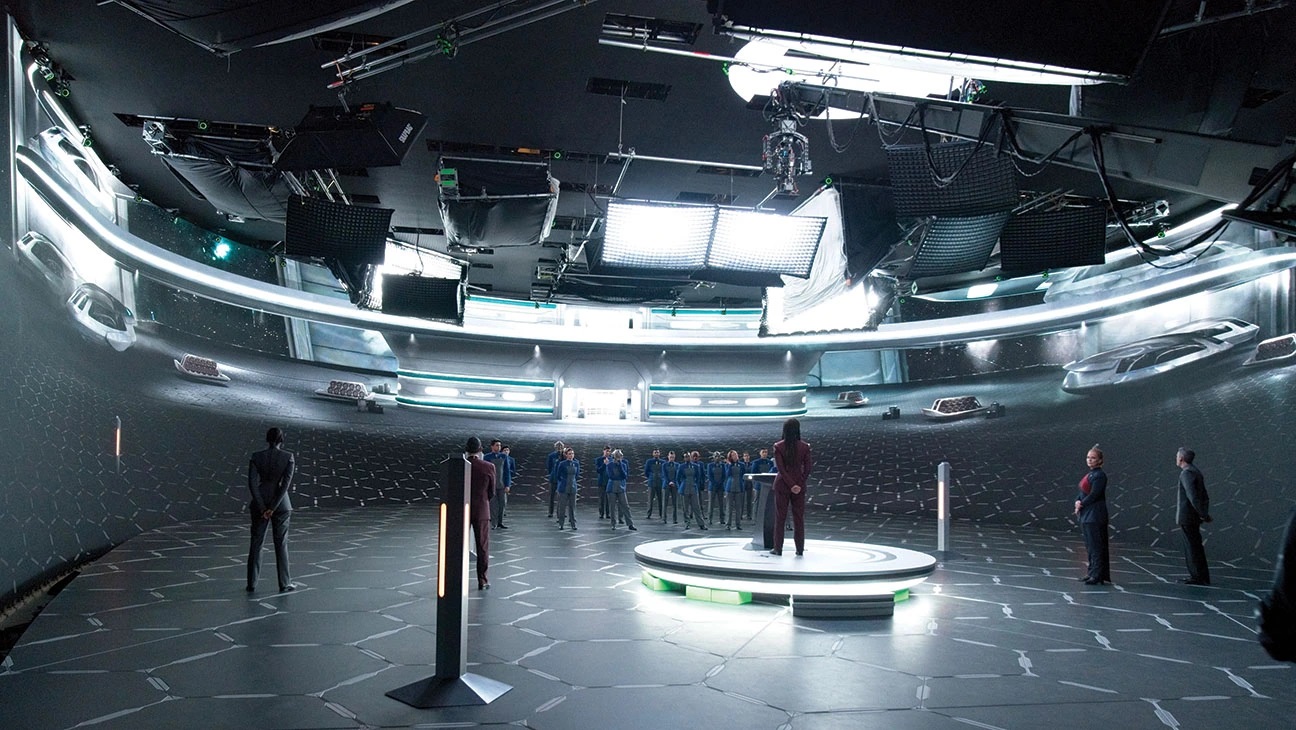Virtual Production Is Driving a Post-COVID Boom in Canada
Insiders say the new technology is a potential game-changer north of the border: “It’s a big eye opener.”
After two years of lockdowns and disruptions, Canada’s production sector appears to be entering into a post-COVID boom.
As proof, look no further than the fact that American streaming giants and broadcasters are not only returning to Canada for location shoots — they’re setting up shop for good with new builds of production stages, soundstages and studios.
“The fact that Netflix is taking long-term leases and buying studio space, the fact that CBS did that as well, you’re seeing big international entities seeing value in investing in real estate to service their productions here and are committed to staying,” says Mark Bishop, co-CEO of Toronto-based indie producer marblemedia, creator of the reality glass-art competition series Blown Away on Netflix.
The boom is being driven in part by Canada’s robust VFX industry, which is ushering in a new era of virtual production in Toronto and Vancouver that offers tremendous time and cost savings for local and foreign shoots.
FX production house Pixomondo, which has offices in Toronto, Vancouver and Montreal, and Canadian partner William F. White International, a rental equipment supplier and studio operator, are currently planning to expand beyond Canada, where they have four virtual production stages to service the busy U.S. and U.K. markets.
“We’re expanding [in the U.S. and U.K. markets] where our clients want us to be,” says Paul Bronfman, chairman and CEO of Comweb Corp. and a senior adviser to William F. White.
The main virtual production stage in Toronto is currently hosting shoots for Star Trek: Discovery and Star Trek: Strange New Worlds, and one of the Vancouver stages is home to Netflix’s massive Avatar: The Last Airbender series.
Virtual production, which offers the flexibility of seamlessly creating exotic locales — even imaginary ones — within the confines of a soundstage, has been a game-changer, and Canada is well-positioned to fully capitalize on the new technology.
FX giant Industrial Light & Magic plans to open a new virtual production stage in 2022 near its Vancouver facility to augment its StageCraft system used in producing the Disney+ series The Mandalorian.
“It’s a big eye-opener. Once people go through the workflow and experience [virtual production], there’s no way back. They ask why would we even do it the old way?” says Mahmoud Rahnama, studio head and VFX supervisor at Pixomondo Canada.
And Canadian artists already skilled at digital set construction and virtual art-department work are now being trained industrywide to operate next-generation virtual production stages.
Elsewhere, Dune VFX house DNEG opened a new studio in Toronto in 2021 after growing existing facilities in Vancouver and Montreal and having additional facilities in London, Los Angeles and India; Goodbye Kansas Studios is set to open a studio in Vancouver; Folks VFX recently opened its fourth studio in Quebec; and Solis Animation has launched Crooked City Studios to produce animation content in Toronto as the industry has worked out how artists can work remotely and use cloud infrastructure.
“It’s exciting to have large companies set up in Toronto. Competition shouldn’t be feared. It’s a way of life. It challenges us to do better,” says Neishaw Ali, president and executive producer of Spin VFX in Toronto, which has produced a host of sequences for the locally shot The Umbrella Academy series for Netflix.
Jonathan Bronfman, co-founder and co-president of visual effects startup Monsters Aliens Robots Zombies — the Toronto house behind the effects for Marvel’s WandaVision, HBO’s Watchmen and Invasion for Apple TV+ — says that while it still makes sense for Hollywood productions to shoot in production hubs like Georgia, when it comes to postproduction, Ontario’s various tax incentives offer cost savings that are too good to pass up, such as a provincial animation and special effects tax credit that offsets 18 percent of qualifying local labor expenditures and a production services tax credit that rebates another 21.5 percent of qualifying Ontario production expenditures.
“One of our breakthrough shows was Watchmen,” he says. “When it shoots in Georgia, they can still come up to Ontario as they did and access all [tax] credits.”
The production rally north of the border also is being driven by fast-growing construction of soundstages in major production hubs in and around Toronto, Vancouver and Calgary.
Ontario film commissioner Justin Cutler at Ontario Creates says his province’s studio capacity is set to expand by 2.1 million square feet, or 60 percent, in the next three years to 5.3 million square feet.
And to meet a growing subscriber demand for streaming film and TV content, top studio markets in Toronto and Vancouver now see developers investing in campus-size facilities to host shoots for streaming originals.
That expansion is being led by U.S.-based property developer Hackman Capital Partners and its MBS Group studio equipment supply affiliate, which is building a 500,000-square-foot Basin Media Hub film studio on Toronto’s waterfront, and proposing an investment of another $200 million to build a film and TV production studio at the former Downsview air base in the city’s north end as part of a larger commercial development.
“That’s opening up R&D opportunities, new technological options for producers and new training opportunities for local crews, creatives and producers in general to do more work in the province,” Cutler explains.
Elsewhere, Prem Gill, CEO of Creative BC, which markets British Columbia to Hollywood for lucrative location shoots, says her province has 121 soundstages and is growing its studio capacity as private-equity money flows to local studio lot operators.
Surging film and TV production in Alberta has been sparked by the provincial government scrapping a $10 million tax credit cap to allow bigger-budget American shoots to head to Calgary and Edmonton.
Says Calgary film commissioner Luke Azevedo: “We are well above 500,000 square feet of space with an incentive that now is enticing for global productions at the highest-level budgets, which can now be in Alberta and its competitive environment. That tells us the business here is on a trajectory of growth.”

CREDIT: Michael Gibson/Paramount+
Levine wonders if she’ll soon be using her new iPhone 12, which has Lidar light detection and ranging capability, to scout locations. “I know I’m probably going to have to use it at some point,” she allows.
“American Gods” location manager John Rakish, the guild’s 2nd vice president, has also noticed a move to virtual scouting. “There’s a lot more digital photography” when scoping out a site, he says. “It’s not like before where 35 people get in a van to look at a location.” Rakish has taken to using drones to capture 3D footage, which he then sends back to directors or the scout team.
Levine says she has witnessed other changes on set, not just in scouting. For instance, before COVID-19, up to 100 crew members at a time would dine on craft services in expandable trailers. “Now we put six people in [the trailer],” she says. “One show I was working on outfitted those trailers with shower curtains as separators, and they were used as hair and makeup stations.”
Levine says that even such basics as the logistics of a car scene are impacted by health considerations. “We would normally drive around with a camera car and the car would be on a tow dolly,” she says. “But putting two people in an enclosed spaced in a COVID world — you can’t do that anymore.”
In one instance — a site in Santa Clarita that was supposed to double for Florida — the space just didn’t work under the existing conditions. But the crew found a solution with CGI: “Virtual shooting plates were used against a blue screen, and the sequence, in which a mother is teaching her daughter how to drive, was shot on a soundstage instead of on location.”
Levine points out that it’s not just location managers who are pivoting. Writers, too, are rethinking big background sequences. A scene that was once on the page as taking place in a crowded bar is now just a lone bartender stocking a shelf while a customer walks in. “We’re all adapting to change,” she says.
Credit:
Etan Vlessing | Hollywood Reporter
January 31, 2022
https://www.hollywoodreporter.com/movies/movie-news/virtual-production-covid-canada-1235080848/
